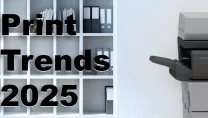The need for print within a business is constantly changing. Key trends around Automation, Sustainability, and Innovation have the potential to bring greater productivity, cost-savings and flexibility to businesses. Here we look at how the print trends for 2024 will evolve.
In the first part of our print predictions and trends for 2024, we looked at how connected devices are being impacted by the emergence of smarter AI, how print security and privacy around cloud data are essential for print and beyond. This time, we explore how automation is helping change the way the print industry operates, why sustainability must remain a key business concern, and the drivers for innovation in an industry that for many is seen as a mature technology.
Automation of Print Processes
Automation of processes within business is nothing new, streamlining workplace efficiency is a trend that delivers for both the employer and the employee. The removal of manual steps from routine operations speeds up productivity, reduces overall costs, while at the same time enables staff to focus on more rewarding tasks.
MFPs still have a role to play in the automation of many businesses as often there is content that is in analogue form that needs to be added to digital workflow processes. A trend that continues to gather traction with customers centres on moving away from centralised processes in favour of custom workflows. Even without the need to access the code level, tools are now available to enable even the smallest of businesses to automate manual and laborious tasks with ease.
As with many of the trends we are seeing, this will only become easier with the application of AI. Until recently, Process Automation was a very expensive thing to indulge in, requiring expensive consultancy and a bespoke build and configuration of systems. The application of AI can now take what is like a standard platform and make something very personalised and unique to a specific customer in a very cost-effective way.
Greener Ways of Printing
In recent years, sustainability and environmental issues have become top priorities for companies. Despite economic challenges, businesses must invest in green initiatives now to ensure a viable future. The print industry in Europe is seeing new sustainability regulations introduced, either as draft proposals to give manufacturers time to prepare, or as laws taking effect.
One area in which the industry is seeing change is in that of remanufactured or refurbished devices. IDC research suggests that by 2027, global enterprises will seek to shift 10 per cent of their fleet acquisitions to remanufactured or refurbished devices. While this trend is very much focussed on enterprise level volumes of print devices, we do expect the trend to move to small and medium-sized businesses seeking to save money and improve sustainability through the recycling and reusing of print devices.
Across Europe we continue to see initiatives that advance and refine sustainability measures. For print, the European regulators are continuing to introduce new regulations, either in draft form, so manufacturers have sight of what to expect, or are now actually being implemented, and becoming law.
Though there is no quick fix, ongoing efforts are driving progress in making business operations more eco-friendly over the long term. For example the Eco-design for Sustainable Products Regulation (ESPR) is a new ruling that has been proposed and will improve the circularity, energy performance and other environmental sustainability aspects of products in the EU.
One aspect of the ESPR regulation that we are seeing as a trend concerns extending the lifespan of components. Customers typically look to refresh their print solutions every five years on average. However, as print volumes drop the natural life of devices can be extended without any disadvantage to service or efficiency. The remote monitoring and management of print devices in these situations will be key to helping reduce costs, waste, and extend lifecycle expectations.
The drive towards greater sustainability within print is a trend that is only set to gather pace. MFPs and printers are increasingly being designed and manufactured as appliances, or devices that effectively run their whole lifespan without requiring any service of the components. As a result, Sharp continues to develop its own strategy around the materials we use for manufacture as well as that of the packaging deployed – something that was explored in our recent MFP Developer interview.
Incremental Innovation in Print
There is no getting away from the fact that for the most part ‘print’ is a mature technology. Print speeds can be improved, efficiencies around power usage can be made but the underlying technology remains the same. Therefore, innovation trends within print tend to be more incremental and are often about creating more cost-effective devices, whether that is in the cost of purchase, or in maintenance costs. This is especially true as hybrid working becomes more established, workplaces more fractured, and the need for print volumes being eroded.
As a result, the trend for 2024 and beyond is the need for A3 print capabilities within SMEs being replaced by an emphasis on A4 print devices. This is an industry trend reacting to the changing nature of print. Not only is the cost of acquisition cheaper but they can also be more cost-effective to run and support, which additionally helps to further support sustainability aims within a business.
That is not to say A3 is going away any time soon, as it still plays a major role within many organisations. The trend we are seeing is that the number of centralised large workgroup traditional A3 devices will reduce as businesses adjust to the new norm of the modern workplace environment. As a result, A4 devices with similar feature sets but more suitable for smaller teams or workgroup will become more prevalent.
If you missed it, In the first part of our look at the print trends that will impact SMEs in 2024, we look at the emergence of AI in print, the need for print security, and the evolving roll of cloud and data permissions for easier printing.
This article was compiled following a discussion with the Sharp Europe product marketing team: Jason Cort (European Director Product Management and Marketing), Rob Davis (Solutions & Services Business Manager), Claudio Roselli (Head of Product Management and Software Development), and Ben Lake (Senior Product Manager - MFP & Printer Products).





